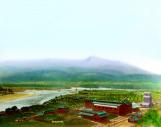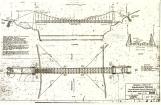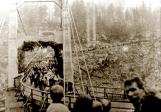12
Life in the village began at the break of dawn; the women arising and starting a large and hearty vegetarian breakfast. Breakfast began with prayers and group singing, and once breakfast was finished, there would be more psalms, hymns and prayers before starting the day. In the early years, the day meant pulling stumpage, cutting timber and clearing the Doukhobor lands but later, those tasks were replaced with falling timber for profit or maintaining the orchards and grain fields they kept.From milling timber to milling flour, to planting and harvesting their fields of orchards of grain, the Doukhobors' life was certainly not one of leisure and their motto "Toil and Peaceful Life" was as alive in practice during this time, as in any time of their history.
13
Oche Nash (The Lord's Prayer) sung in Russian1967
Grand Forks, BC, Canada
 Credits:
Credits:Centenial Doukhobor Choir
14
Along with the prerequisite prayers, hymns and psalms, lunch would be a communal experience as well (unless the workers were hired out to enterprises outside the community's needs). At the end of the work day, a communal dinner was served and as with breakfast, prayers, hymns and psalms preceded the meal and continued after. Bedtime was early, for a new day would begin soon enough. The work day was usually an 11 hour ordeal but no one really kept a 'time sheet'.15
Sobranie (Peter V. Verigin cethered in grey suit)Circa 1920s
Brilliant, BC, Canada
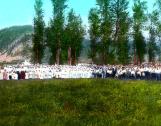 Credits:
Credits:From the Autochrome Exhibit, Doukhobor Village Museum, Castlegar, BC
16
Work was six days per week while the Sabbath (Sunday) was respected and was usually incorporated into large sobranies where Doukhobors could gather with Doukhobors from other villages in praise of the Almighty. It was no doubt that these sobranies also served a social function for people from one village to meet with those from another, and it was also during these sobranies that many a courtship had started between a young man and woman from different villages.18
In all of the Doukhobors' enterprises, perhaps none were as impressive as the jam factory and the resultant enterprises of such. The K.C. Preservative Works began in 1910 in Brilliant, at the confluence of the Columbia and Kootenay Rivers, and continued in operation past the demise of the CCUB, and until December 1943. This would become the main office for all the CCUB enterprises from here to Saskatchewan.21
Lush Brilliant, BC OrchardsLate 1910s
Brilliant, BC, Canada
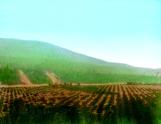 Credits:
Credits:From the Autochrome Exhibit, Doukhobor Village Museum, Castlegar, BC
22
The jam factory (as with most other Doukhobor enterprises) flourished during this period. Preservatives were used not only by the Doukhobors themselves but markets opened up from English-speaking non-Doukhobors. The Ooteshenie side's bountiful harvest was originally transported by a ferry operated by the Doukhobors, across the Kootenay River for processing at the KC Jam Factory (as it became known).Also, produce from Ooteshenie was becoming popular to all groups and getting this produce to market was getting to be a continual problem with the ferry, mostly because of fluctuating river levels. The jam factory also offered an opportunity to other non-Doukhobor independent growers to sell their produce which the Doukhobors would even go pick. The growers themselves described these relations with the Doukhobors as satisfactory and fair.
